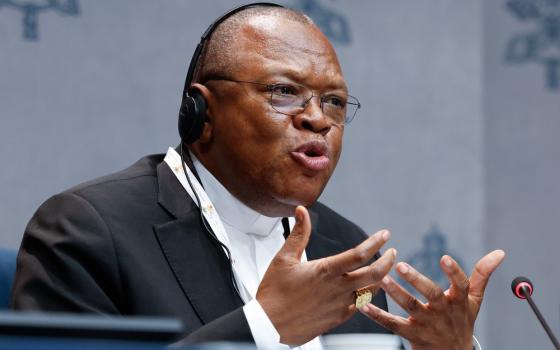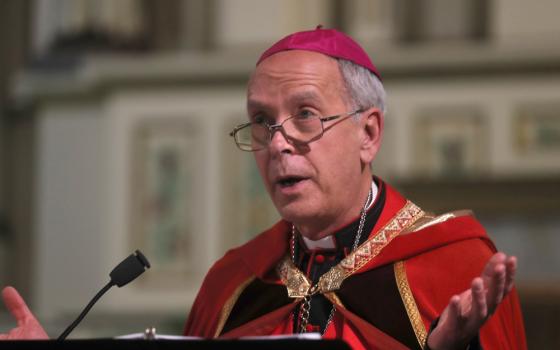Every year in January we celebrate the Week of Prayer for Christian Unity. And every year we seem to be not an inch closer to outright reunion -- at least on the official level.
At the unofficial level, however, Christians are worshipping and receiving Communion in one another's liturgies. And many Catholics, especially younger Catholics, do not even think along denominational lines when referring, for example, to weddings and funerals.
That is because the Second Vatican Council understood the church as ecumenical, that is, embracing "the whole wide world" of Christians. The Body of Christ consists not only of Catholics, but also Eastern Orthodox, Anglicans (in the United States they are known as Episcopalians), Protestants, and Oriental Christians alike.
In the years, decades, and centuries preceding the council, the common assumption of Catholics and the official teaching of the Catholic church was that the Catholic church is "the one, true church of Christ."
All other churches and ecclesial communities were regarded as "false churches," completely outside the Body of Christ and beyond the pale of salvation.
------------------------------------------------------------------------------
Over the next several weeks, Fr. McBrien's columns will explore the major ecclesiological themes or principles proclaimed at the Second Vatican Council.
Vatican II themes: The church as mystery, or sacrament
Vatican II themes: The people of God
Vatican II themes: The church as servant
Vatican II themes: The church as communion
Vatican II themes: The church is ecumenical
------------------------------------------------------------------------------
Vatican II decisively changed that mentality. The Decree on Ecumenism defined the goal of the ecumenical movement as the "restoration" of Christian unity, not the "return" of the separated brethren to the preexisting unity of the Catholic church (n. 1)
As disruptive as were the East-West Schism of the 11th century and the Reformation of the 16th, the communion among and between the churches was not completely destroyed. That is why the council viewed the goal of the ecumenical movement as the restoration of "full communion with the Catholic church" (n. 3, my italics).
The council also acknowledged that "people on both sides were to blame" for the historic breach of Christian unity, and that the baptized living today "are put in some, though imperfect, communion with the Catholic church" (n. 3).
Therefore, the differences between and among separated Christians always "exist in varying degrees." Because of this all "have a right to be called Christians, and with good reason are accepted as sisters and brothers in the Lord by the children of the Catholic church."
Indeed many of the most important ecclesial elements are found outside as well as inside the Catholic church: the Sacred Scriptures; the life of grace; faith, hope, and charity, along with the other interior gifts of the Holy Spirit. As such, the Holy Spirit can use these separated churches as means of salvation.
The pastoral consequences of the council's teaching on the ecumenicity of the church have been the formal dialogues (also known as "consultations" and "bilaterals") between the Catholic church and other Christian churches at the local, national, and international levels; a common pursuit of renewal and reform; cooperation in the social apostolate; joint theological study in seminaries, colleges, and universities; common prayer, particularly on special occasions and the aforementioned Week of Prayer for Christian Unity; and various initiatives toward the mutual recognition of one another's ordained ministries.
One of the most controversial texts in all of the documents of Vatican II is that of article 8 of the Dogmatic Constitution on the Church (Lumen gentium). The church "subsists in" the Catholic church, rather than "is" the Catholic church, as the earlier text had it.
Other changes in the article worth noting include the dropping of the adjective "Roman" and the replacement of "Roman Pontiff" with "the successor of Peter."
The argument over the correct interpretation of article 8 achieved renewed intensity in July 2007 with the publication of Responses to Some Questions Regarding Certain Aspects of the Doctrine on the Church by the Vatican's Congregation for the Doctrine of the Faith (CDF).
The CDF document took issue with the common interpretation given by theologians and council fathers alike, namely, that the council changed the wording from "is" to "subsists in" to break the exclusive connection between the Catholic church and the Body of Christ.
The CDF declared, somewhat densely, that "subsistence means this perduring historical continuity and the permanence of all the elements instituted by Christ in the Catholic church, in which the church of Christ is concretely found on this earth."
Nevertheless, the weight of interpretation of article 8 continues to favor the great majority of theologians and bishops who have directly commented on this matter.
Jesuit Fr. Francis Sullivan, long-time professor of ecclesiology at the Pontifical Gregorian University in Rome, gave the best translation of the subsistit in clause as "continues to exist fully only in the Catholic church."
The key word is "fully." In introducing the notion of "degrees of communion," Vatican II gave us the best way of interpreting the ecumenicity of the church.
© 2011 Richard P. McBrien. All rights reserved. Fr. McBrien is the Crowley-O'Brien Professor of Theology at the University of Notre Dame.
|
Editor's Note: We can send you an e-mail alert every time Fr. McBrien's column, "Essays in Theology," is posted to NCRonline.org. Go to this page and follow the directions: E-mail alert sign-up. If you already receive e-mail alerts from us, click on the "update my profile" button to add "Essays in Theology" to your list. |


